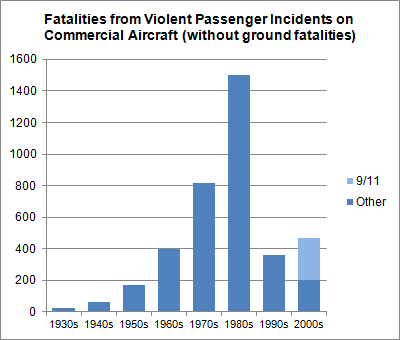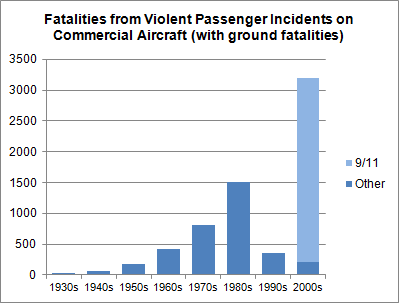Nate Silver at FiveThirtyEight posted some graphs that show a clear decrease in passenger deaths as a result of Violent Passenger Incidents (hijackings, sabotage/bombings, pilot shootings) since the 1980s:

Of course, the vast majority of people killed on 9/11 weren’t in the planes, but on the ground; if you include those, then 2001 has a much higher fatality level than any other year:

Silver’s point is that because of 9/11 and attempted bombings since then, many people are under the impression that the danger of violent incidents on planes is increasing. But it clearly isn’t–the number of passengers killed per decade as a result of such incidents has gone down even as plane travel has become more widespread and the number of people in the air each year has increased.
He also suggests,
…the loss of life that occurred on the ground on 9/11 would be very hard for Al Qaeda or any other terrorist group to replicate. The reason is that the last line of defense against the terrorists has also proven to be the best, and that is the passengers. Brave passengers thwarted the hijacking attempts aboard United 93 and Qantas 173, and sabotage attempts aboard NWA 253 and AA 63 (the Shoe Bomber incident).
This isn’t, obviously, meant to say that we shouldn’t worry about airline security or that the loss of life on 9/11 is unimportant. It’s just a good example of how it can be difficult to judge whether the risk of things is increasing or decreasing, particularly when they’re scary, and incidents that are actually quite rare can seem to be happening “all the time” once we’re thinking about, and noticing reports of, them.

Comments 21
Dr. Ivo Robotnik — January 5, 2010
YER SIDIN' WITH THEM THAR TURRURRISTS! >8C
cb — January 5, 2010
This is a good post. I think I'll bookmark it for the people I know who won't fly because of hijack possibilities. I already quote statistics on driving fatalities vs. airplane fatalities, but it's always good to have more facts on hand!
Deaf Indian Muslim Anarchist — January 5, 2010
It's also easy to think that terrorist hijackings are on the rise becuase it's so widely reported on the news, thanks to the Internet, news blogs, Twitter, etc...
Keeley — January 5, 2010
...I'm guessing the 80s showed a huge increase in airline use without a parallel increase in security?
mordicai — January 5, 2010
As I just said on Jezebel about this same topic: "Math is HARD!"
Elena — January 5, 2010
I would like to know the number of terrorist incidents per decade. This might be more related with overall woldwide sociopolitic changes (number of hijackings, number of airplane bombings) than to brave passengers going Chuck Norris on terrorists.
Jon — January 5, 2010
Very interesting post, but I think a key piece regarding the location of these incidents is missing from Nate’s original post. In the decades prior to 2001, few of these incidents occurred in the United States or on flights to the United States. But in the past nine years alone, the United States witnessed the September 11 hijackings and two examples of attempted bombings on flights to the United States. Several high-profile events in the span of a few years. Is it any surprise that some Americans express fear or a belief that the risk of violent incidents on planes is increasing?
I don’t subscribe to this mentality. However, I am certainly aware that many Americans remain apathetic to events around the world until it directly impacts them. When it became apparent that the US was vulnerable to airline terrorism, many Americans (fed by media and the Bush administration) became hyper-sensitive to the fear that it could happen to them, ignorant to the history of these events throughout the world and statistical probabilities.
Brandon — January 5, 2010
Another interesting observation based on the graph...
In the last decade, more people died from plane crashes who weren't on planes themselves than actual airplane passengers.
You COULD make the argument that you're safer on the plane than on the ground.
We don't fear death from a plane crashing into us when we're not on a plane... but fear of death isn't known for being rational.